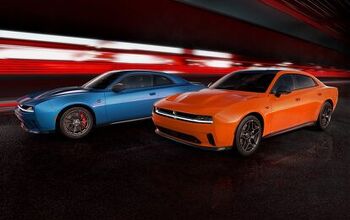The Dodge Charger Daytona EV Is Irrelevant To Shoppers

Dodge’s transition to electric power is going about as well as you imagined. Sales data for Q1 2025 show the brand sold more discontinued Chargers and Challengers than its all-new Charger Daytona EV, validating the question of why the battery-powered replacement came first.
Key Points
- Dodge sold more discontinued gas-powered Chargers (1,052) and Challengers (922) than the new Charger Daytona EV (1,947) in Q1 2025.
- The Charger Daytona EV averaged just 22 sales per day nationwide.
- Ford sold 9,377 Mustangs during the same period, despite a sales dip.
From January to March, Dodge moved 1,947 units of the Charger Daytona EV. During the same period, it sold 1,052 ICE Chargers and 922 Challengers—vehicles that were officially discontinued at the end of 2023. Combined, that’s 1,974 of the outgoing V6 and V8-powered models, surpassing sales of the new EV.
By contrast, Ford sold 9,377 Mustangs over the same period, despite a 32 percent decline in Mustang sales year-over-year. Making things look even worse, last year, Dodge moved 9,737 internal combustion Challengers alone in Q1— outselling the Daytona EV by more than five-to-one.
A check of current listings shows there are still hundreds of last-generation Chargers and Challengers available on dealer lots, months after production ended. That leftover inventory suggests that while demand for traditional muscle remains, it's not enough to clear old stock quickly.
Some dealers are still holding on to two-year-old Challenger and Charger Hellcat and SRT models are asking for significant premiums— one dealer in California has six-figure markups on three different SRT Hellcat Challenger models.
Dodge's four-door Charger, as well as internal combustion versions powered by the 3.0-liter Hurricane inline-six, should reach the marketplace shortly, which will likely help shore up demand for the iconic nameplate.
Still, Q1 was a bloodbath across the board for Dodge. Total brand sales dropped 49 percent year-over-year, from 42,948 units to 21,731. The Hornet saw a 45 percent decline with just over 4,100 units sold, while the Durango dropped nine percent to 13,701.
Everyone knew it was going to be bad, but I don't think anyone thought the Q1 results would be this bad.
Become an AutoGuide insider. Get the latest from the automotive world first by subscribing to our newsletter here.

An experienced automotive storyteller and accomplished photographer known for engaging and insightful content. Michael also brings a wealth of technical knowledge—he was part of the Ford GT program at Multimatic, oversaw a fleet of Audi TCR race cars, ziptied Lamborghini Super Trofeo cars back together, been over the wall during the Rolex 24, and worked in the intense world of IndyCar.
More by Michael Accardi




































Comments
Join the conversation
Frankly I'm surprised they even sold 2k of these....
No kidding. That's why they are back tracking and reeling it in lol.